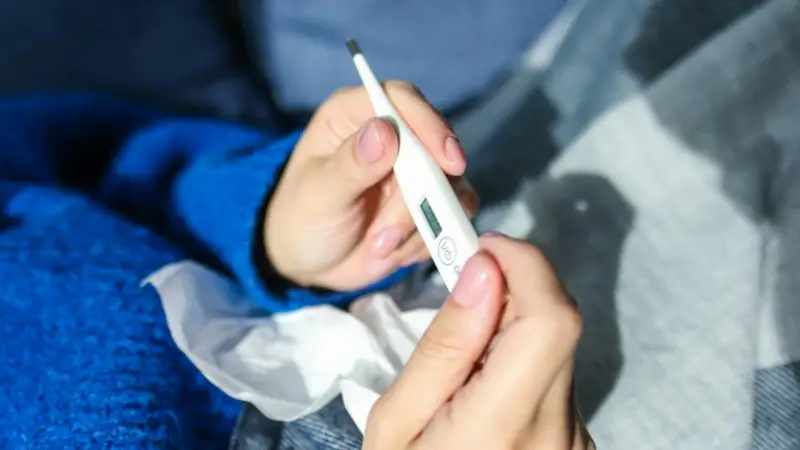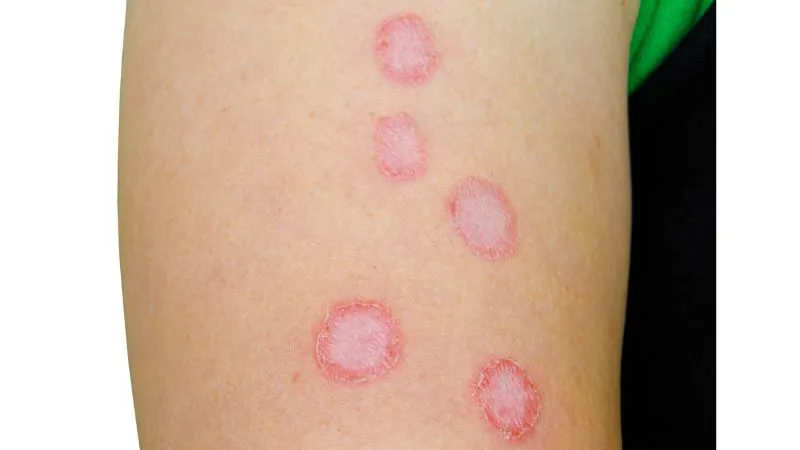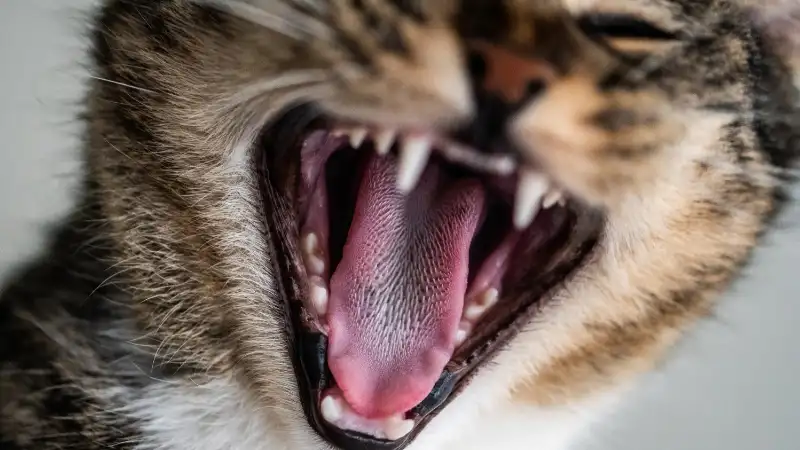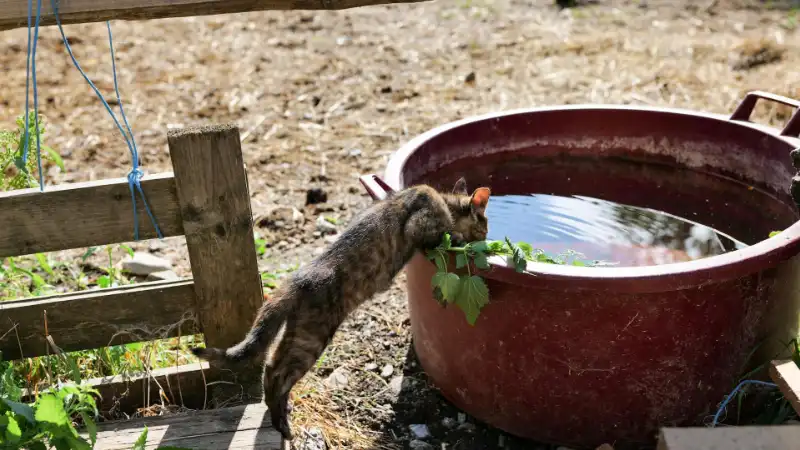As cat owners, we simply love our pets, but we must be aware that they can transmit certain diseases to us. Such a disease is called zoonosis. What are the most common zoonoses?
TOXOPLASMOSIS

It is widespread throughout the world. Both humans and animals can become infected, especially cats, which are its primary host. Individuals with weakened immune systems are particularly susceptible to the infection caused by the parasite Toxoplasma gondii. Humans can become infected in various ways, such as by consuming contaminated food or water, handling infected cat feces, organ transplantation, or transfusion.
The symptoms of toxoplasmosis are similar to the flu, including fever, muscle pain, fatigue, and headache. They are usually mild and resolve within a few weeks. A common symptom is also swollen lymph nodes in the neck area, which is a result of the immune system's response to the infection. In individuals with weakened immune systems, eye problems such as blurred vision or eye pain and sensitivity to light are more common. If infection occurs during pregnancy, the parasite can be transmitted to the unborn child, which can lead to miscarriage, stillbirth, or the birth of a child with signs of congenital toxoplasmosis. Such an infection can lead to permanent consequences, such as vision impairment, seizures, or intellectual disability.
To prevent infection, we implement preventive measures such as maintaining good hygiene, especially when handling raw meat, soil, or cat feces. Meat should always be thoroughly cooked before consumption; freezing also helps by killing the parasites. It is recommended to use separate cutting boards and utensils for raw meat and other foods to prevent cross-contamination. Caution is also advised when drinking water only from controlled water sources. People with weakened immune systems and pregnant women should avoid cleaning cat litter boxes or wash their hands thoroughly afterward. Feces are also often found in home gardens.
In healthy individuals, treatment is usually not necessary as the symptoms resolve on their own. However, treatment for individuals with weakened immune systems is carried out under medical supervision with various medications.
INTESTINAL PARASITES

Internal parasites are very common, especially in outdoor cats. The most common are roundworms and tapeworms, both of which significantly weaken the immune system. Tapeworm infection occurs by ingesting an infected flea or its feces, while roundworms are contracted by drinking contaminated water, eating contaminated food, ingesting eggs in the feces of infected animals, or through the respiratory tract. A good immune system is important as it reduces the likelihood of infection.
Humans can also become infected with roundworms and tapeworms, with young children being particularly vulnerable. Infected cats excrete the developmental stages of roundworms and tapeworms into the environment through their feces, which poses a risk. Ingesting infected meat also poses a risk. Less commonly, ingestion of tapeworm segments can cause the growth of a hydatid cyst, and the only solution is surgical removal.
Often, we don't even know that a cat is infected until the number of parasites increases and the cat loses weight, its coat loses its shine, its appetite changes, it develops diarrhea, vomits, coughs, or has a bloated abdomen. In case of prolonged, untreated infection, the animal can die. With roundworms, a distended abdomen can be noticed, and later they are visible in the feces or can be vomited. Tapeworm segments can be observed in the excreted stool or may stick to the fur around the cat's anus.
With appropriate prevention, i.e., regular administration of deworming medication, we can reduce the likelihood of infestation or ensure their removal. Tablets or spot-on treatments for parasites are available in pharmacies and veterinary clinics. Simultaneous control of external and internal parasites is important, as the intermediate host in tapeworm infection is the flea larva, which ingests the eggs. When the flea matures, the cat can become reinfected if it ingests an adult flea or its feces.
DERMATOPHYTES: MICROSPORUM and TRICHOPHYTON INFECTIONS

Fungal infections of the skin, known as dermatophytoses, are often the result of infections with dermatophytes, which include the genera Trichophyton and Microsporum. These dermatophytes cause diseases such as microsporum and trichophyton infections (ringworm). They are transmitted through direct contact with an infected animal or person. Infection is also possible through contact with contaminated objects such as bedding, brushes, food and water bowls, or clothing. The risk of infection is highest in children and individuals with weakened immune systems. The incubation period is usually between 10 and 14 days, but symptoms may appear later.
In cats, microsporum infection manifests with characteristic symptoms, namely circular reddish changes on the skin and hair loss. Most often, changes are visible on the head, ears, and paws. The affected areas are usually itchy and worsen over time. For cat owners, it is very important to quickly recognize the symptoms of the disease and take action as soon as possible. Early treatment is crucial in stopping the spread of fungal spores in the environment, which can infect other animals and people.
Diagnosis takes place in veterinary clinics, where they perform a hair examination with a special UV lamp (Wood's lamp) or, if necessary, a microscopic examination of hair samples. The treatment process is lengthy and requires a lot of persistence, as the infection can persist for several weeks or even months. Depending on the severity of the infection, treatment includes topical antifungal creams or systemic antifungal medications. 1 During the process, regular cleaning of the environment is also necessary to prevent the spread of spores, which can survive in the environment for several months.
RABIES

It is a deadly disease caused by a virus that affects the central nervous system. Slovenia has been declared a rabies-free country since 2016, and there is no risk in our neighboring countries (Italy, Austria, Hungary, and Croatia) either. A high risk of infection still remains in Asia, Africa, South America, and Eastern Europe. Infection occurs through the bite of an infected animal, contact of damaged skin or mucous membranes with the saliva of an infected animal, through the respiratory mucous membranes in caves with bats, through organ transplantation, or through the bite of an infected person. The incubation period lasts from a few days to several years, during which infected people (and cats) have no problems.
The first signs of infection manifest as fever, headache, nausea, vomiting, fatigue, pain or unusual sensations at the bite site, behavioral disturbances, restlessness, irritability, fearfulness, loss of appetite, insomnia, anxiety, or aggressiveness.
Advanced signs include seizures, severe irritability, hydrophobia, fear, confusion, delirium, hallucinations, excessive salivation, muscle paralysis, high fever, constipation, and urinary retention. The infected person dies due to general paralysis and cardiovascular failure or paralysis of the muscles of the tongue, pharynx, larynx, and respiratory muscles.
Since there is no cure for rabies, it is very important to prevent infection. If we are injured by an infected animal or an animal suspected of being infected, we let the blood flow from the wound, wipe saliva away from the wound (not across it!), rinse the wound under running water with soap, bandage it with a sterile dressing, and immediately see a doctor.
GIARDIA

Single-celled intestinal parasites cause a serious intestinal infection, the consequence of which is frequent diarrhea. The disease is widespread throughout the world. Cats become infected by drinking contaminated water, food, or through surfaces. The parasites live in the intestines, and Giardia cysts are excreted into the environment through feces, where they can survive for several months.
In kittens and immunocompromised cats, diarrhea can be life-threatening as the animal suffers from dehydration. Diarrhea can be watery or bloody, the animal loses appetite, loses weight, vomits, dehydrates, shows fatigue, and develops a matted coat.
Diagnosis is made with fecal tests or a rapid test at the veterinary clinic. Treatment requires a lot of patience as it combines medication, hygienic practices, and cleaning the living environment. Regular cleaning, washing, and disinfection of feeding bowls, the cat bed, the litter box, and other surfaces that the cat comes into contact with are essential. Treatment can be lengthy as Giardia cysts are resistant to environmental factors, so (re)infection is possible even through contaminated surfaces and objects.
To prevent infection, cats should have access to fresh and clean water, a clean living environment, a regularly washed cat bed, and a disinfected litter box.
SALMONELLA

Salmonellosis is a widespread intestinal disease caused by Salmonella bacteria. Sources of infection can include raw eggs, raw meat (especially poultry), poor hand hygiene, or contact with a contaminated surface, and rarely through drinking water.
The incubation period from infection is 6 to 36 hours. In humans and animals, the infection can be asymptomatic. In humans, diarrhea, abdominal pain, vomiting, or fever may occur, while in cats, vomiting, diarrhea, and lethargy may occur.
Specific treatment is usually not necessary in humans; it is important to ensure adequate fluid intake and thorough cleaning of toilets and other surfaces, as Salmonella bacteria are excreted in feces for several weeks after infection. Cat owners must maintain good hand hygiene after each cleaning of the litter box, after contact with the cat, or contact with other potentially contaminated surfaces.
CAT SCRATCH DISEASE - BARTONELLOSIS

Cat scratch disease is a bacterial infection spread worldwide. Cats are the carriers of the disease, having become infected with the bacteria by ingesting flea feces while scratching and licking their fur. Kittens, which do not yet have a developed immune system, and stray cats are most at risk. Infection is prevented by avoiding kittens and stray cats.
The infection is transmitted to humans through bites, scratches, or contact of infected saliva with broken skin or mucous membranes. Most infections are recorded in the autumn and winter, most often in children up to 15 years of age.
The site of the scratch or bite can also be slightly raised or filled with fluid. After 1-3 weeks, lymph node swelling appears near this site, most often in the armpits, neck, or groin area. The lymph nodes are often tender to the touch, the skin is reddened and warm. Fever, headache, sore throat, dizziness, and malaise may also occur. Swollen lymph nodes usually return to their previous state only after 2-4 months. However, the disease can also be completely asymptomatic.
In most cases, treatment is not necessary as the symptoms resolve on their own over time. In people with weakened immune systems, more symptoms and, less frequently, complications may occur. As a rule, individuals who have already been infected acquire lifelong immunity.
CRYPTOSPORIDIOSIS

This contagious intestinal disease is caused by a parasite. The most common mode of infection is through water, food, or contact with an infected person; it is also a frequent cause of diarrhea after swimming in pools. Symptoms appear 2-5 days after infection.
This contagious intestinal disease is caused by a parasite. Infection in individuals with a good immune system can be asymptomatic or cause acute diarrhea. In people with weakened immune systems, it can cause prolonged watery diarrhea, which can even be fatal. It is also transmitted through the feces of infected people and animals. The parasite is protected by a capsule, which allows it to survive for a long time outside the host's body.
Infection is prevented with proper hand hygiene, sanitation of toilets and other potentially contaminated surfaces, and washing hands after contact with animals. Individuals who have recovered from the infection should avoid visiting public swimming pools for at least 14 days.
There is no specific treatment; rest, adequate hydration, and consumption of high-quality, varied food rich in vitamins and minerals are necessary.
Our lovely animals can transmit some diseases to us, but with regular information, adequate knowledge, products against external and internal parasites, and good hygiene, we can successfully avoid this. So, zoonoses should not be a reason to avoid animals. Let's dedicate our time to them and simply love them as they deserve with their adorableness.